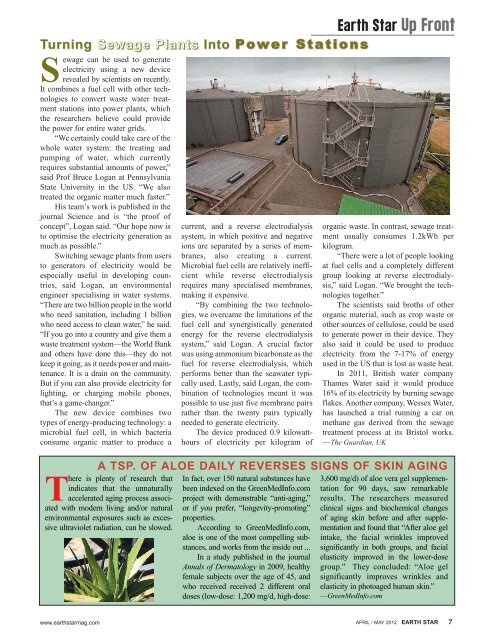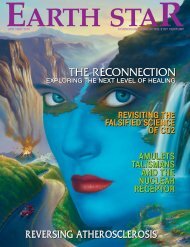You also want an ePaper? Increase the reach of your titles
YUMPU automatically turns print PDFs into web optimized ePapers that Google loves.
TurningSewage Plants Into P o w e r S t a t i o n sSewage can be used to generateelectricity using a new devicerevealed by scientists on recently.It combines a fuel cell with other technologiesto convert waste water treatmentstations into power plants, whichthe researchers believe could providethe power for entire water grids.“We certainly could take care of thewhole water system: the treating andpumping of water, which currentlyrequires substantial amounts of power,”said Prof Bruce Logan at PennsylvaniaState University in the US. “We alsotreated the organic matter much faster.”His team’s work is published in thejournal Science and is “the proof ofconcept”, Logan said. “Our hope now isto optimise the electricity generation asmuch as possible.”Switching sewage plants from usersto generators of electricity would beespecially useful in developing countries,said Logan, an environmentalengineer specialising in water systems.“There are two billion people in the worldwho need sanitation, including 1 billionwho need access to clean water,” he said.“If you go into a country and give them awaste treatment system—the World Bankand others have done this—they do notkeep it going, as it needs power and maintenance.It is a drain on the community.But if you can also provide electricity forlighting, or charging mobile phones,that’s a game-changer.”The new device combines twotypes of energy-producing technology: amicrobial fuel cell, in which bacteriaconsume organic matter to produce aA TSP. OFThere is plenty of research thatindicates that the unnaturallyaccelerated aging process associatedwith modern living and/or naturalenvironmental exposures such as excessiveultraviolet radiation, can be slowed.current, and a reverse electrodialysissystem, in which positive and negativeions are separated by a series of membranes,also creating a current.Microbial fuel cells are relatively inefficientwhile reverse electrodialysisrequires many specialised membranes,making it expensive.“By combining the two technologies,we overcame the limitations of thefuel cell and synergistically generatedenergy for the reverse electrodialysissystem,” said Logan. A crucial factorwas using ammonium bicarbonate as thefuel for reverse electrodialysis, whichperforms better than the seawater typicallyused. Lastly, said Logan, the combinationof technologies meant it waspossible to use just five membrane pairsrather than the twenty pairs typicallyneeded to generate electricity.The device produced 0.9 kilowatthoursof electricity per kilogram ofEarth Star Up Front. OF ALOE DAILY REVERSES SIGNS OF SKIN AGINGIn fact, over 150 natural substances havebeen indexed on the GreenMedInfo.comproject with demonstrable “anti-aging,”or if you prefer, “longevity-promoting”properties.According to GreenMedInfo.com,aloe is one of the most compelling substances,and works from the inside out ...In a study published in the journalAnnals of Dermatology in 2009, healthyfemale subjects over the age of 45, andwho received received 2 different oraldoses (low-dose: 1,200 mg/d, high-dose:organic waste. In contrast, sewage treatmentusually consumes 1.2kWh perkilogram.“There were a lot of people lookingat fuel cells and a completely differentgroup looking at reverse electrodialysis,”said Logan. “We brought the technologiestogether.”The scientists said broths of otherorganic material, such as crop waste orother sources of cellulose, could be usedto generate power in their device. Theyalso said it could be used to produceelectricity from the 7-17% of energyused in the US that is lost as waste heat.In 2011, British water companyThames Water said it would produce16% of its electricity by burning sewageflakes. Another company, Wessex Water,has launched a trial running a car onmethane gas derived from the sewagetreatment process at its Bristol works.—The Guardian, UK3,600 mg/d) of aloe vera gel supplementationfor 90 days, saw remarkableresults. The researchers measuredclinical signs and biochemical changesof aging skin before and after supplementationand found that “After aloe gelintake, the facial wrinkles improvedsignificantly in both groups, and facialelasticity improved in the lower-dosegroup.” They concluded: “Aloe gelsignificantly improves wrinkles andelasticity in photoaged human skin.”—GreenMedInfo.comwww.earthstarmag.com APRIL / MAY 2012 E<strong>ARTH</strong> <strong>STA</strong>R 7
















